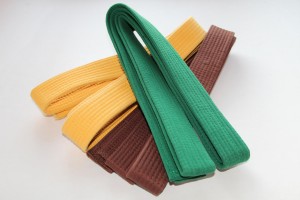In Shorinji Kempo, we have, as in most other Japanese budo (martial arts), a grading system. The grading system (kaikyū seido [階級制度]) is set up as a step by step curriculum so that it is easier to learn and it is based on the idea of zenzen shugaku [漸々修学], ie. step by step learning. All branches in the whole world follows the same kamokuhyō (curriculum), which also specifies minimum requirements for how long time it must be between gradings, and how many practice sessions you need before you are qualified to test for the next level. In Shorinji Kempo, there are three different types of ranks, they are explained in more detail in the following paragraphs. All grading certificates, for both kyū as well as dan ranks, are issued by Shorinji Kempo Hombu.

Bukai
The first type of grading one encounter is bukai [武階], “martial rank”, which means kyū and dan ranks, just as in most other martial arts. These gradings include both a practical test of the techniques, as well as a theoretical test. For kyū grades it is a written homework and for dan grades it is a written homework and a written test on the day of the grading. For higher dan grades there is also an interview.
For children that are 9 years old or younger there are eight kyū ranks and for all who are 10 years or older there are six kyū ranks. Children that are 12 years or younger have a somewhat different kamokuhyō (curriculum) where all so called gyaku waza (techniques that attacks joints) are removed. Kyū ranks begin with a high figure and goes down to first kyū which is the level before black (dan grade). When one are new one wear a white belt, this is called minarai (beginner). The youngest children have yellow belt for the ranks of 8th & 7th kyū, then there are green belt for the grades 6th, 5th, & 4th kyū, and brown belt for 3rd, 2nd & 1st kyū. Dan ranks begin with 1 dan (shodan), 2 dan (nidan) and so on, up to 9 dan which is the highest bukai rank in Shorinji Kempo.

Hōkai
The second type of degree is hōkai [法階], which roughly means philosophical rank. If you meet the criteria, you can get the first four hōkai ranks together with the corresponding bukai rank. Then hōkai ranks come after bukai, one must have had fifth dan a certain period of time before one can make the written test for next hōkai rank daikenshi, etc. This is the order of the hōkai ranks: junkenshi [准拳士], shōkenshi [少拳士], chūkenshi [中拳士], seikenshi [正拳士], daikenshi [大拳士], junhanshi [准範士], seihanshi [正範士], daihanshi [大範士].

Sōkai
The third type of ranking in Shorinji Kempo is sōkai [僧階], “priesthood ranks.” These are for those who join sōseki [僧籍] (priesthood). There are eleven levels of sōkai and they are shō dōshi [少導師], gon chū dōshi [権中導師], chū dōshi [中導師], gon dai dōshi [権大導師], dai dōshi [大導師], gon shō hōshi [権少法師], shō hōshi [少法師], gon chū hōshi [権中法師], chū hōshi [中法師], gon dai hōshi [権大法師], dai hōshi [大法師].
In principle, one must train in a dōin (available only in Japan) to get sōkai ranks.









 Home
Home

